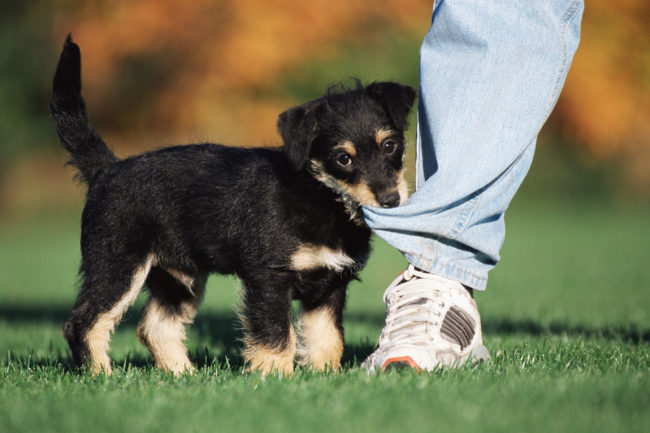
Something different today. If you were in distress and needed to be rescued, would your pet dog do so even if it had no training on how to do that?
A study by researchers at Arizona State University’s Department of Psychology decided to explore the Lassie legend and see if it was really possible and also why.
Here is what they did
Van Bourg and Wynne, an ASU professor of psychology and director of the Canine Science Collaboratory at ASU, set up an experiment assessing 60 pet dogs’ propensity to rescue their owners. None of the dogs had training in such an endeavor.
In the main test, each owner was confined to a large box equipped with a light-weight door, which the dog could move aside. The owners feigned distress by calling out “help,” or “help me.”
They recorded it all. Here is an example …
Within the above you have two scenarios: in the first the dog’s owner is inside the box, crying out in distress. In the second the same person is in the box, reading calmly.
Is it Obedience or Concern?
Beforehand, the researchers coached the owners so their cries for help sounded authentic. In addition, owners weren’t allowed to call their dog’s name, which would encourage the dog to act out of obedience, and not out of concern for her owner’s welfare.
“About one-third of the dogs rescued their distressed owner, which doesn’t sound too impressive on its own, but really is impressive when you take a closer look,” Van Bourg said.
That’s because two things are at stake here. One is the dogs’ desire to help their owners, and the other is how well the dogs understood the nature of the help that was needed. Van Bourg and Wynne explored this factor in control tests — tests that were lacking in previous studies.
Do the dogs know what to do?
In one control test, when the dog watched a researcher drop food into the box, only 19 of the 60 dogs opened the box to get the food. More dogs rescued their owners than retrieved food.
“The key here is that without controlling for each dog’s understanding of how to open the box, the proportion of dogs who rescued their owners greatly underestimates the proportion of dogs who wanted to rescue their owners,” Van Bourg said.
“The fact that two-thirds of the dogs didn’t even open the box for food is a pretty strong indication that rescuing requires more than just motivation, there’s something else involved, and that’s the ability component,” Van Bourg said. “If you look at only those 19 dogs that showed us they were able to open the door in the food test, 84% of them rescued their owners. So, most dogs want to rescue you, but they need to know how.”
Do the dogs hear their owner and simply wish to be with them?
In another control test, Van Bourg and Wynne looked at what happened when the owner sat inside the box and calmly read aloud from a magazine. What they found was that four fewer dogs, 16 out of 60, opened the box in the reading test than in the distress test.
“A lot of the time it isn’t necessarily about rescuing,” Van Bourg said. “But that doesn’t take anything away from how special dogs really are. Most dogs would run into a burning building just because they can’t stand to be apart from their owners. How sweet is that? And if they know you’re in distress, well, that just ups the ante.”
The fact that dogs did open the box more often in the distress test than in the reading control test indicated that rescuing could not be explained solely by the dogs wanting to be near their owners.
Behaviour Observations
The researchers also observed each dog’s behavior during the three scenarios. They noted behaviors that can indicate stress, such as whining, walking, barking and yawning.
“During the distress test, the dogs were much more stressed,” Van Bourg said. “When their owner was distressed, they barked more, and they whined more. In fact, there were eight dogs who whined, and they did so during the distress test. Only one other dog whined, and that was for food.”
What’s more, the second and third attempts to open the box during the distress test didn’t make the dogs less stressed than they were during the first attempt. That was in contrast to the reading test, where dogs that have already been exposed to the scenario, were less stressed across repeated tests.
“They became acclimated,” Van Bourg said. “Something about the owner’s distress counteracts this acclimation. There’s something about the owner calling for help that makes the dogs not get calmer with repeated exposure.”
 In essence, these individual behaviors are more evidence of “emotional contagion,” the transmission of stress from the owner to the dog, explains Van Bourg, or what humans would call empathy.
In essence, these individual behaviors are more evidence of “emotional contagion,” the transmission of stress from the owner to the dog, explains Van Bourg, or what humans would call empathy.
“What’s fascinating about this study,” Wynne said, “is that it shows that dogs really care about their people. Even without training, many dogs will try and rescue people who appear to be in distress — and when they fail, we can still see how upset they are. The results from the control tests indicate that dogs who fail to rescue their people are unable to understand what to do — it’s not that they don’t care about their people.
Where will they go with all this, what comes next?
“Next, we want to explore whether the dogs that rescue do so to get close to their people, or whether they would still open the box even if that did not give them the opportunity to come together with their humans,” Wynne added.
Further Reading
PLOS (April 16, 2020) – Pet dogs (Canis lupus familiaris) release their trapped and distressed owners: Individual variation and evidence of emotional contagion
(Posting via materials provided by ASU)

Before I was diagnosed with sleep apnea, there were a couple of times when I awoke to find my dog on my bed pawing at my chest. I felt short of breath, and when I woke up, my dog went back to sleep. (Of course it’s also possible that my snoring annoyed her)
Another of my dogs used to live with a baby. For about the first year or two that I owned her, she tried to get behind the TV or go outside every time she heard a baby cry on TV (also when puppies cried). She finally figured out what the TV is, but she still responds to the sounds when she hears them.
But if a burglar came in, she would roll onto her back and demand a belly rub, or redirect her distress onto a toy, so I don’t count on her to rescue me.